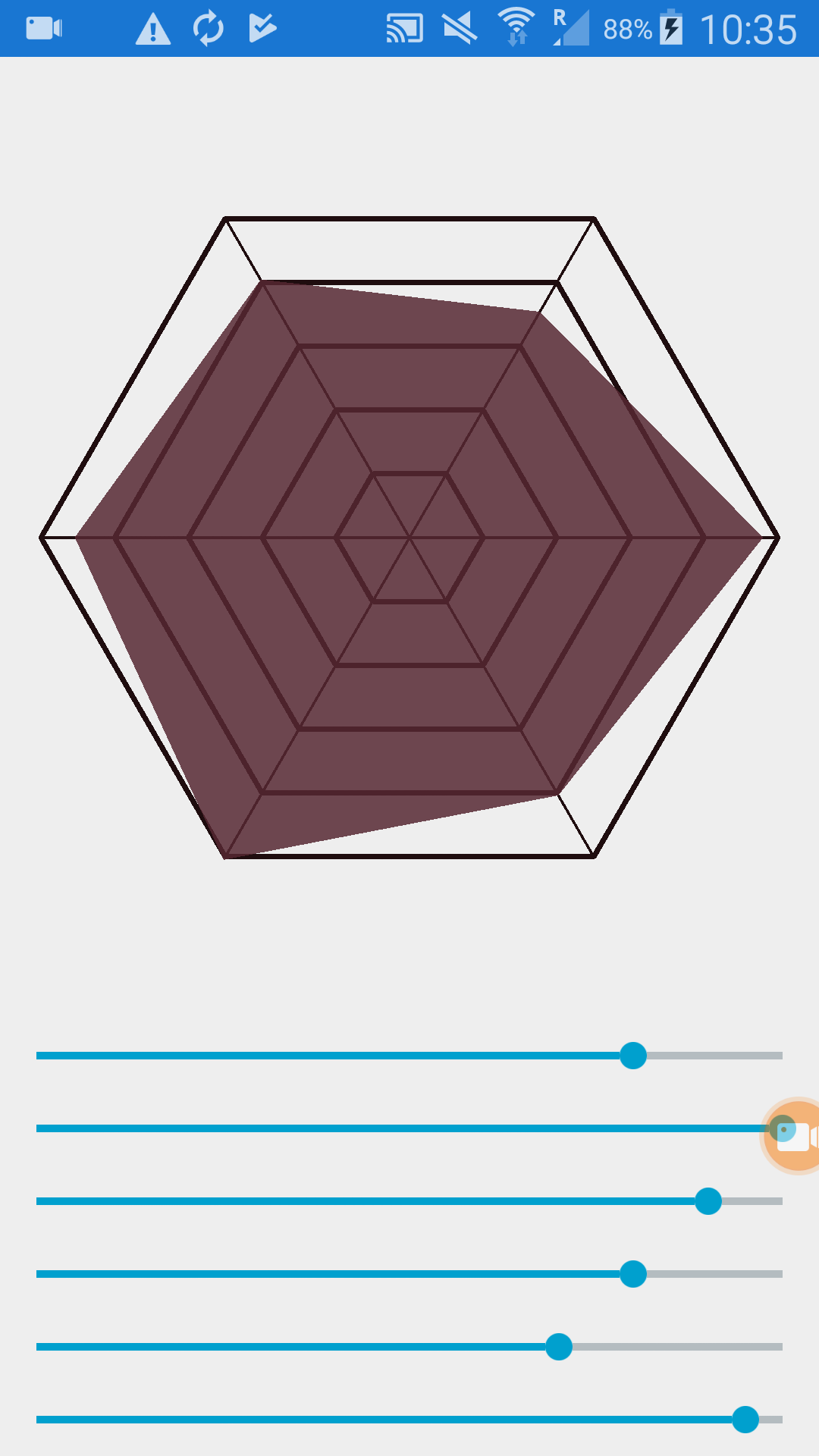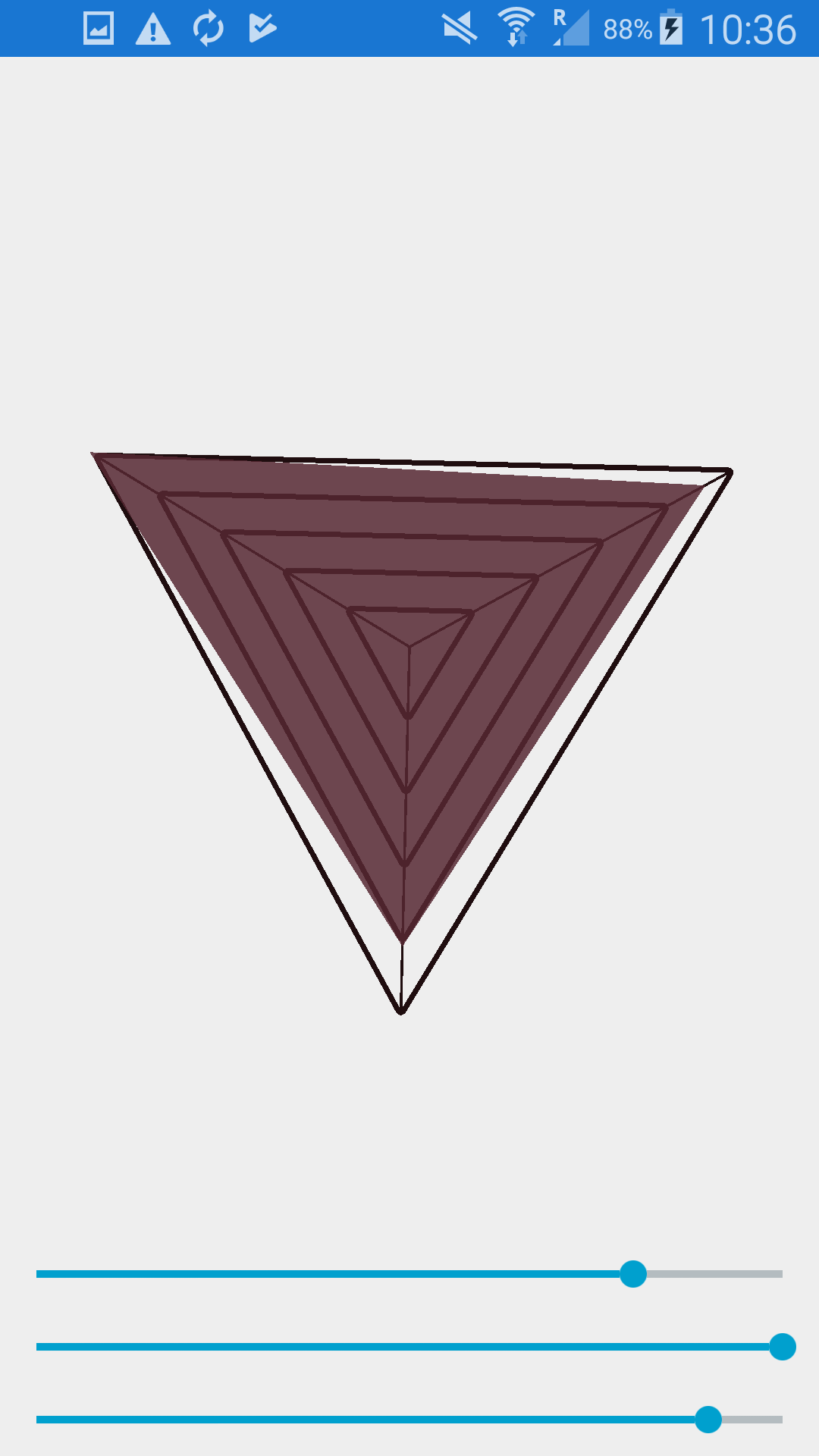Créer un graphique en polygone en Xamarin

Je me suis amusé a réaliser une représentation graphique sur un polygone aux nombre de vertex et graduation variables avec des slider permettant de modifier les valeur des séries.
Voici trois exemples d’implémentation avec le nombre de vertex de 3, 4 et 6



Voici le code de la classe qui génère le graphique.
using System;
using System.Collections.Generic;
using System.Text;
using SkiaSharp;
using SkiaSharp.Views.Forms;
namespace PolygonGraph.Models.Services
{
public class PolygonGraphOptions
{
public const float ANGLE_STRAIGHT = -0.5f;
public const float ANGLE_DEFAULT = 0f;
private float angleStart = ANGLE_DEFAULT;
public float AngleStart
{
get { return angleStart; }
set { angleStart = value; }
}
private int countVertices = 6;
public int CountVertices
{
get { return countVertices; }
set { countVertices = value; }
}
private int countGraduations = 5;
public int CountGraduations
{
get { return countGraduations; }
set { countGraduations = value; }
}
private float cornerRadius = 4;
public float CornerRadius
{
get { return cornerRadius; }
set { cornerRadius = value; }
}
private float graduationStrokeWidth = 7;
public float GraduationStrokeWidth
{
get { return graduationStrokeWidth; }
set { graduationStrokeWidth = value; }
}
private float scaleFrom = 0;
public float ScaleFrom
{
get { return scaleFrom; }
set { scaleFrom = value; }
}
private float scaleTo = 100;
public float ScaleTo
{
get { return scaleTo; }
set { scaleTo = value; }
}
}
public class PolygonGraph
{
private PolygonGraphOptions options;
private SKCanvas canvas;
private SKSurface surface;
private SKImageInfo info;
private List<string> categories;
private List<double> data;
public PolygonGraph(PolygonGraphOptions options)
{
this.options = options;
}
public PolygonGraph DrawCanvas(SKPaintSurfaceEventArgs args)
{
this.info = args.Info;
this.surface = args.Surface;
this.canvas = surface.Canvas;
canvas.Clear();
canvas.Translate(info.Width / 2, info.Height / 2);
drawPolygons();
drawAxes();
return this;
}
public PolygonGraph setCategories(List<string> categories)
{
this.categories = categories;
return this;
}
public PolygonGraph setData(List<double> data)
{
this.data = data;
return this;
}
private void drawPolygons()
{
for (int gIndex=0; gIndex < options.CountGraduations; gIndex++)
{
addPolygonToCanvas(gIndex);
}
}
private void drawAxes()
{
for (int vIndex = 0; vIndex < options.CountVertices; vIndex++)
{
addAxeToCanvas(vIndex);
}
}
/// <summary>
/// Return the angle of a vertex.
/// </summary>
/// <param name="vertexIndex"></param>
/// <returns></returns>
private double getVertexAngle(int vertexIndex)
{
double vertexAngle = this.options.AngleStart; // straight up = -0.5f
return vertexAngle + (2 * Math.PI / this.options.CountVertices) * (vertexIndex+1);
}
/// <summary>
/// Return the radius of the circle from a graduation. 0.5 make a far away point. 0 make a point in center;
/// </summary>
/// <param name="graduationIndex"></param>
/// <returns></returns>
private float getRadiusByGraduation(int graduationIndex)
{
float denMax = 0.45f;
float denMin = 0f;
float denDiff = denMax - denMin;
float denScale = denDiff / options.CountGraduations;
float den = denMax - denScale * graduationIndex;
return den * Math.Min(info.Width, info.Height);
}
private float getRadiusByValue(double value)
{
float denMax = 0.45f;
float denMin = 0f;
float denDiff = denMax - denMin;
float dataDiff = options.ScaleTo - options.ScaleFrom;
float dataPercent = (float)value / dataDiff * 100;
float den = denMin + denDiff * dataPercent / 100;
return den * Math.Min(info.Width, info.Height);
}
/// <summary>
/// Get the exact X, Y of a vertext from the vertex index and graduation index
/// </summary>
/// <param name="vertexIndex"></param>
/// <param name="graduationIndex"></param>
/// <returns></returns>
private SKPoint getSKPointByCoordinates(int vertexIndex, int graduationIndex)
{
float radius = getRadiusByGraduation(graduationIndex);
double vertexAngle = getVertexAngle(vertexIndex);
return new SKPoint(radius * (float)Math.Cos(vertexAngle), radius * (float)Math.Sin(vertexAngle));
}
private SKPoint getSKPointByValue(int vertexIndex)
{
float radius = getRadiusByValue(data[vertexIndex]);
double vertexAngle = getVertexAngle(vertexIndex);
return new SKPoint(radius * (float)Math.Cos(vertexAngle), radius * (float)Math.Sin(vertexAngle));
}
void addAxeToCanvas(int vertexIndex)
{
SKPoint vertexPoint = getSKPointByCoordinates(vertexIndex, 0);
SKPoint center = new SKPoint(0, 0);
// Create the path
using (SKPath path = new SKPath())
{
// Begin at the first midpoint
path.MoveTo(vertexPoint);
path.LineTo(center);
path.Close();
// Render the path from vertex to center of graph
using (SKPaint paint = new SKPaint())
{
paint.Style = SKPaintStyle.Stroke;
paint.Color = Xamarin.Forms.Color.FromHex("#1F0D0F").ToSKColor();
paint.StrokeWidth = options.GraduationStrokeWidth / 2;
canvas.DrawPath(path, paint);
}
}
}
void addPolygonToCanvas(int graduationIndex)
{
SKPoint[] vertices = new SKPoint[this.options.CountVertices];
SKPoint[] midPoints = new SKPoint[this.options.CountVertices];
double vertexAngle = 0f * Math.PI; // straight up = -0.5f
// Coordinates of the vertices of the polygon
for (int vertex = 0; vertex < this.options.CountVertices; vertex++)
{
vertices[vertex] = getSKPointByCoordinates(vertex, graduationIndex);
vertexAngle = getVertexAngle(vertex);
}
// Coordinates of the midpoints of the sides connecting the vertices
for (int vertex = 0; vertex < this.options.CountVertices; vertex++)
{
int prevVertex = (vertex + this.options.CountVertices - 1) % this.options.CountVertices;
midPoints[vertex] = new SKPoint((vertices[prevVertex].X + vertices[vertex].X) / 2, (vertices[prevVertex].Y + vertices[vertex].Y) / 2);
}
// Create the path
using (SKPath path = new SKPath())
{
// Begin at the first midpoint
path.MoveTo(midPoints[0]);
for (int vertex = 0; vertex < this.options.CountVertices; vertex++)
{
SKPoint nextMidPoint = midPoints[(vertex + 1) % this.options.CountVertices];
// Draws a line from the current point, and then the arc
path.ArcTo(vertices[vertex], nextMidPoint, this.options.CornerRadius);
// Connect the arc with the next midpoint
path.LineTo(nextMidPoint);
}
path.Close();
// Render the path in the center of the screen
using (SKPaint paint = new SKPaint())
{
paint.Style = SKPaintStyle.Stroke;
paint.Color = Xamarin.Forms.Color.FromHex("#1F0D0F").ToSKColor();
paint.StrokeWidth = options.GraduationStrokeWidth;
canvas.DrawPath(path, paint);
}
}
}
public void drawData()
{
SKPoint[] vertices = new SKPoint[this.options.CountVertices];
SKPoint[] midPoints = new SKPoint[this.options.CountVertices];
double vertexAngle = 0f * Math.PI; // straight up = -0.5f
// Coordinates of the vertices of the polygon
for (int vertex = 0; vertex < this.options.CountVertices; vertex++)
{
vertices[vertex] = getSKPointByValue(vertex);
vertexAngle = getVertexAngle(vertex);
}
// Create the path
using (SKPath path = new SKPath())
{
// Begin at the first midpoint
path.MoveTo(vertices[0]);
for (int vertex = 0; vertex < this.options.CountVertices; vertex++)
{
path.LineTo(vertices[vertex]);
}
path.Close();
// Render the path in the center of the screen
using (SKPaint paint = new SKPaint())
{
paint.Style = SKPaintStyle.StrokeAndFill;
paint.Color = Xamarin.Forms.Color.FromHex("#562832").ToSKColor().WithAlpha(215);
paint.StrokeWidth = options.GraduationStrokeWidth;
canvas.DrawPath(path, paint);
}
}
}
public void refreshData()
{
drawData();
}
}
}
Le code XAML de la page où j’insère mon graphique
<?xml version="1.0" encoding="utf-8" ?>
<ContentPage xmlns="http://xamarin.com/schemas/2014/forms"
xmlns:x="http://schemas.microsoft.com/winfx/2009/xaml"
xmlns:local="clr-namespace:PolygonGraph"
xmlns:skia="clr-namespace:SkiaSharp.Views.Forms;assembly=SkiaSharp.Views.Forms"
x:Class="PolygonGraph.MainPage">
<StackLayout x:Name="MainLayout" Spacing="0" Padding="0" Margin="0">
<skia:SKCanvasView PaintSurface="OnCanvasViewPaintSurface" x:Name="GraphCanvasView" VerticalOptions="FillAndExpand" HorizontalOptions="FillAndExpand">
</skia:SKCanvasView>
</StackLayout>
</ContentPage>
Le code cs de la page xaml
public partial class MainPage : ContentPage
{
protected Models.Services.PolygonGraph graph;
private List<double> _data;
private List<string> _categories;
private List<Slider> _sliders;
public MainPage()
{
InitializeComponent();
_data = new List<double> { 80, 100, 90, 80, 70, 95 };
_categories = new List<string> { "cat 1", "cat 2", "cat 3", "cat 4", "cat 5", "cat 6", };
_sliders = new List<Slider>();
graph = new Models.Services.PolygonGraph(new Models.Services.PolygonGraphOptions());
graph.setCategories(_categories).setData(_data);
for(int index=0; index<_data.Count(); index++)
{
Slider slider = new Slider(0, 100, _data[index]);
slider.Margin = 0;
slider.ValueChanged += OnSliderValueChanged;
_sliders.Add(slider);
MainLayout.Children.Add(slider);
}
}
void OnCanvasViewPaintSurface(object sender, SKPaintSurfaceEventArgs args)
{
graph.DrawCanvas(args);
graph.drawData();
}
void OnSliderValueChanged(object sender, ValueChangedEventArgs args)
{
int index = 0;
foreach (Slider slider in _sliders)
{
if (slider == (Slider)sender) break;
index++;
}
_data[index] = args.NewValue;
graph.setData(_data);
GraphCanvasView.InvalidateSurface();
}
}
Le code est disponible sur github : https://github.com/julien-its/xamarinPolygonGraph
